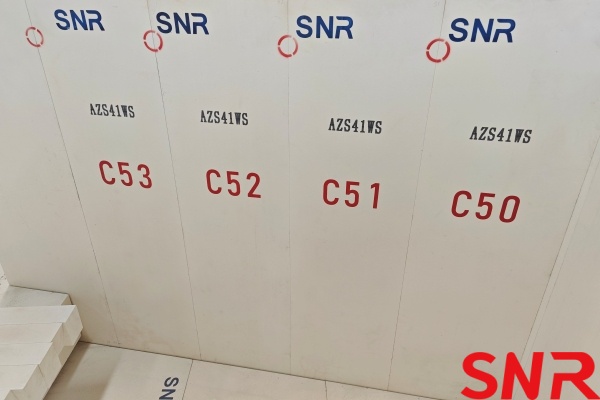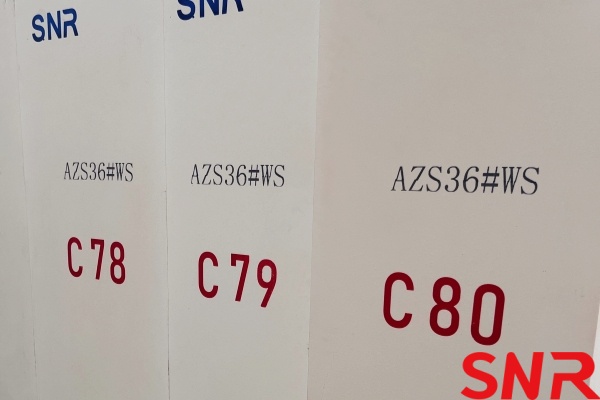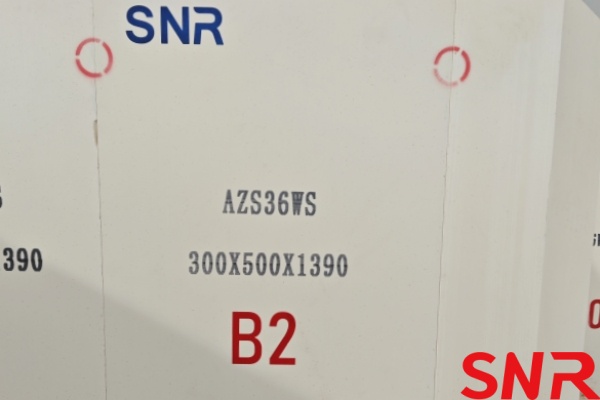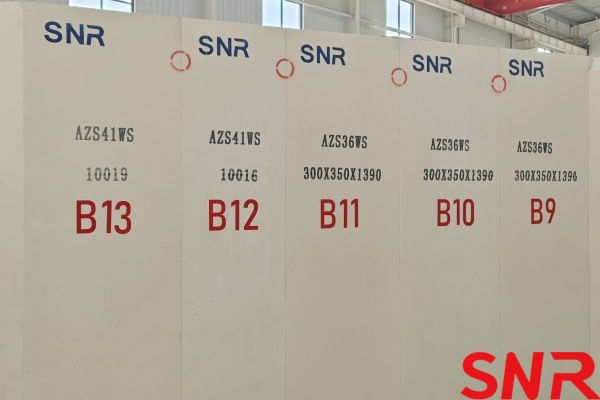1. Introduction
Fused cast AZS refractory materials belong to inorganic non-metallic brittle materials. During production, the unstable baddeleyite crystals contained in fused cast AZS refractory materials undergo a tetragonal-to-monoclinic phase transformation during annealing, resulting in volume expansion. The resulting stress and strain can lead to the formation of cracks in the castings. Repeated testing and optimization of casting and annealing process parameters can control or eliminate the formation of such cracks.
The phase transformation of baddeleyite is accompanied by significant volume expansion and contraction. The unusual aspect of this volume change is that when the temperature rises, the baddeleyite phase transformation (monoclinic-to-tetragonal) causes contraction, while when the temperature decreases, the baddeleyite phase transformation (tetragonal-to-monoclinic) causes expansion, with the volume change during expansion being greater than during contraction (Figure 1).
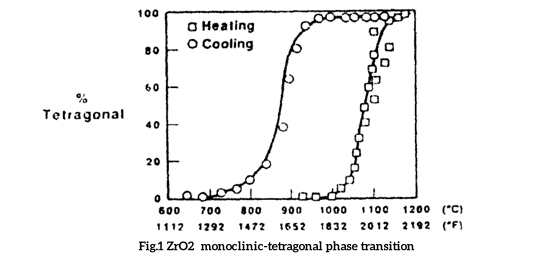
Therefore, when temperature fluctuates, ZrO2-containing materials exhibit gradual expansion, and the resulting phase transformation stress is greater than anticipated, potentially causing the material to crack during use, forming penetrating cracks.
Visible cracks frequently appear at the upper end of fused cast AZS sidewall blocks during glass furnace heating or operation, affecting the service life of the blocks and the stability of glass furnace performance, and even leading to customer complaints. Therefore, this study analyzes the causes of crack formation at the upper end of fused cast AZS sidewall blocks and explores methods to reduce or prevent such cracks to achieve optimal performance.
2. Classification and Location of Upper End Cracks
Currently, the sidewalls of glass furnaces have moved away from the traditional multi-layer horizontal block arrangement and instead use single-piece tilted casting or quasi-shrinkage-free casting of fused cast AZS sidewall blocks in vertical arrangements. This eliminates the severe upward drilling erosion caused by horizontal block joints, extending the service life of the blocks. The insulation structure of the sidewall is determined based on the erosion profile of the sidewall blocks. The upper end of the sidewall blocks at the glass melt line experiences severe erosion, while the area below the melt line is less affected. The common practice domestically and internationally is to avoid insulating the upper end of the sidewall blocks and to use strong air cooling on the outer surface of the sidewall blocks at the glass melt line, while insulating the lower part of the sidewall blocks below the melt line.
The cracks that appear at the uninsulated upper end of fused cast AZS sidewall blocks are mostly vertical and horizontal cracks, with vertical cracks occurring more frequently (which can manifest as penetrating cracks). These cracks often appear in a single group, and other cracks such as mesh are occasionally seen. The likelihood of both vertical and horizontal cracks appearing on the same block is relatively low. Vertical cracks are typically located at the center of the upper end of the fused cast AZS sidewall blocks (see Figure 2), with lengths of about 150-200 mm. Some vertical cracks can extend below the top of the insulation layer. Horizontal cracks appear near the top of the insulation layer of the sidewall blocks, with lengths matching the width of the block. Comparatively, horizontal cracks are more harmful to the use of fused cast AZS sidewall blocks than vertical cracks, and also hinder the normal work of later tiling or tying blocks to protect the glass furnace.
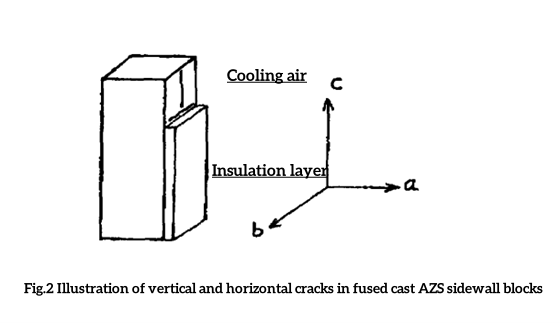
3. Analysis of Crack Causes and Prevention Methods
3.1 Cracks Occurring During Glass Furnace Heating
The baking process of the glass furnace is to evenly heat the refractory materials in the whole glass furnace, release the stress and volume effect of the refractory materials during the heating process, and stabilize the solidification of the amorphous refractory materials. This process mainly includes planned programs such as temperature rise, expansion, and glass furnace pressure control. During the early stages of heating, the focus of refractory monitoring is on silica bricks, with the temperature rise rate characterized by slow and uniform increases. The strain from expansion of fused cast AZS refractory blocks is small and not enough to cause cracks in the block. In the subsequent fire stage, as temperatures further increase, fused cast AZS refractory blocks gradually exhibit non-elastic expansion under the influence of ZrO2 phase transformation. If lack of forethought, lack of control measures, or insufficient attention is given, this strain may exceed the minimum fracture strain allowed by the material at that temperature, leading to block cracking and crack formation. In particular, the upper end of the fused cast AZS sidewall brick is subject to the interaction of internal and external hot and cold winds, and the thermal stress in the block accumulates very quickly (Table 1), which easily leads to the formation of cracks.
Table 1: Instantaneous axial tensile stress at the center of the upper end of sidewall blocks, 120 mm from the hot face
|
Temperature (°C) |
Heating Rate (°C/hr) |
Tensile Stress (MPa) |
|
920 |
15 |
4.3, 22.2, 18.5 |
|
Allowable Value |
/ |
σ max ≤ 22.5 MPa |
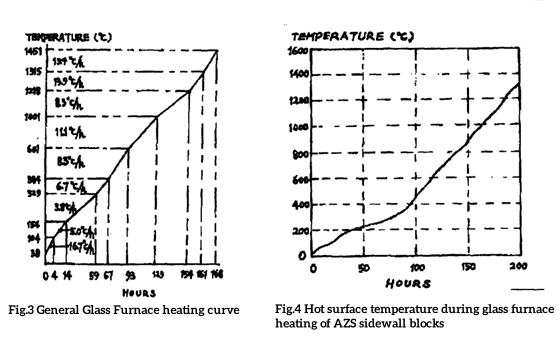 The conventional heating curve for glass furnaces is shown in Figure 3, representing a seven-day heating schedule. Depending on the glass furnace size, there may be a 2–3-day filling period, and the heating cycle length may vary. For 300t-500t/d float glass furnaces, when the melting zone temperature reaches 925°C and the cooling zone temperature reaches above 700°C, the fire stage can begin. When the temperature rises to 1300°-1400°C, hot charging can commence. Figure 4 shows the temperature changes at the hot face of fused cast AZS sidewall blocks in a medium-sized flat glass furnace during heating.
The conventional heating curve for glass furnaces is shown in Figure 3, representing a seven-day heating schedule. Depending on the glass furnace size, there may be a 2–3-day filling period, and the heating cycle length may vary. For 300t-500t/d float glass furnaces, when the melting zone temperature reaches 925°C and the cooling zone temperature reaches above 700°C, the fire stage can begin. When the temperature rises to 1300°-1400°C, hot charging can commence. Figure 4 shows the temperature changes at the hot face of fused cast AZS sidewall blocks in a medium-sized flat glass furnace during heating.
For light industrial glass furnaces, which are relatively smaller in area, many companies prefer to shorten the heating cycle to five days, and some even reduce it to three days. Since silica bricks for glass furnace crowns exhibit significant non-linear expansion characteristics—50% expansion at 204°C, 90% at 427°C, and maximum expansion at 760°C (where the hot face temperature of silica blocks is about 871°C)—these properties largely determine the heating schedule below 900°C. To ensure heating safety, the temperature rise rate in the main expansion temperature range of silica blocks generally should not exceed 5.5°C/hr. In other words, shortening the heating cycle means increasing the heating rate in the later stage of the glass furnace baking., which increases the temperature difference between the inside and outside and top and bottom of fused cast AZS sidewall blocks, particularly at the upper end, leading to increased thermal stress and causing cracking.
Therefore, to prevent crack formation at the upper end of fused cast AZS sidewall blocks during heating, it is essential to adjust the position of hot air burners, ignition sequence, and fuel quantity, gradually increase combustion air volume, and start reversing to prevent cold air intake. Strict adherence to the heating curve and effective control of the temperature rise rate are necessary to avoid significant temperature fluctuations. Additionally, because sidewall cooling air can cause a sharp peak in thermal stress in this area, the magnitude of the peak is closely related to the temperature at which cooling air is initiated. Experiments show that there is basically no peak value when blowing cooling air at the beginning of the temperature rise. The peak value generated by blowing cooling air at 1200℃ is more than twice that at 560℃. The stress peak value of blowing cooling air at an operating temperature of 1450℃ is more than three times that at 560℃. According to the actual situation of domestic glass companies, the air should be supplied in an appropriate amount from the ignition of the glass furnace. The maximum temperature of the cooling air should not exceed 500℃. The air volume should not be adjusted too large at the beginning to ensure that the temperature difference at the upper end of the sidewall block before and after the cooling air is blown is not too large. Furthermore, for medium and large glass furnaces, it is important to frequently and slightly loosen the sidewall restraining bolts during heating, especially the longitudinal ones along the glass furnace length. At high temperatures, the thermal expansion of bottom blocks will push against the sidewall blocks placed on them. If the sidewall bolts are not loosened in time, horizontal cracks may form at the upper end of the sidewall blocks.
3.2 Cracks Occurring During Use
After the glass furnace is put into use after the glass furnace is baked, the thermal strain at the upper end of the sidewall blocks tends to be stable, and the blocks have a certain plasticity. However, due to the intense convection of the glass liquid, the intermittent addition of materials causes the liquid level to fluctuate up and down, and the half-molten batch material contains incompletely decomposed mirabilite, soda ash and other components that are more corrosive than pure glass liquid, as well as the interaction of liquid, solid and gas phases, which makes the erosion and scouring of this part more serious. The unevenness of erosion and scouring causes the thickness of the blocks to be uneven, resulting in greater differences in the size and direction of local thermal stress, and a reversal of the thermal stress distribution. Its strength value exceeds the flexural strength of the material at this temperature (Table 2, the flexural strength of the material is usually higher than its tensile strength), which can also cause this part of the block to twist and crack, and visible cracks to appear.
Table 2: Flexural strength of fused cast AZS 33# blocks under tensile strain
|
Temperature (°C) |
Flexural Strength (MPa) |
|
20 |
88.5 |
|
400 |
89.6 |
|
600 |
88.5 |
|
700 |
86.4 |
|
800 |
81.0 |
|
900 |
72.5 |
|
950 |
36.8 |
|
1000 |
21.3 |
|
1100 |
14.9 |
|
1200 |
10.7 |
|
1300 |
7.5 |
|
1400 |
4.3 |
Paying attention to the use and maintenance of fused cast AZS sidewall blocks can reduce the degree of block erosion, reduce the formation of the above cracks, and extend the service life of blocks. If the temperature difference between the two sides of the glass furnace is too large or the feeder is unevenly fed, the batch material entering the glass furnace often deviates to one side of the glass furnace, and there is basically no batch material on the other side. The batch material in the glass furnace is unevenly distributed on both sides of the melting furnace, that is, the batch material deviates, and the erosion of the sidewall blocks will increase sharply. Measures such as adding feeders or adding material blocking water pipes can be taken to prevent the batch material from deviating and avoid excessive erosion of the sidewall blocks. The purpose of air cooling the sidewall blocks is also for this purpose. However, the ideal air-cooling effect of the sidewall blocks depends not only on factors such as air volume, speed, blowing angle and block thickness, but also on the difference in hot spots of the sidewall to achieve precise air supply. Especially when the remaining thickness of the sidewall blocks is reduced to about 100mm, the air-cooling effect is best at this time. Precise air supply can further slowdown the accumulation of stress and strain of the sidewall blocks and prevent the formation of the above cracks.
4. Conclusion
The analysis of crack formation at the upper end of fused cast AZS sidewall blocks in glass furnaces during heating and operation shows that although there are many factors contributing to such cracks, careful construction during the heating stage, enhanced maintenance of sidewall refractories during use, and comprehensive measures can eliminate or prevent these cracks, thereby improving the service life of sidewall blocks and extending the glass furnace campaign.
Henan SNR Refractory Co., Ltd. is dedicated to the manufacture,research and development of fused cast AZS refractory materials and bonded refractory materialsfor glass industry. Meanwhile, SNR can provide total solutions and services for glass furnace design, glass furnace construction, renovation, and upgrading. Please contact me if you have any requirements.
.png) CONTACT: zoe@snrefractory.com/
CONTACT: zoe@snrefractory.com/ WhatsApp:+86 18172389584
WhatsApp:+86 18172389584


